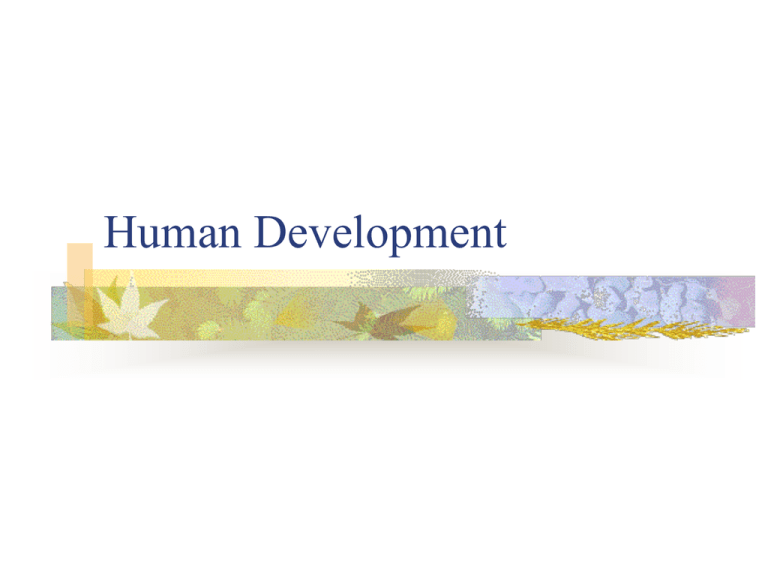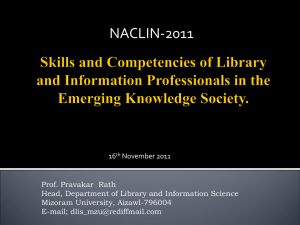Human Development
advertisement

Human Development Children According to Piaget, children progress through 3 stages: 1. Sensorimotor: 0 to 2 years Learn about the world by associating sensory experiences with physical actions. 2. Preoperational: 2-7 years. Associate world with words and images. 3. Concrete Operational: 7-11 years. Begin to reason logically about concrete events. Learning Styles 1. 2. 3. There are 3 basic learning styles: Auditory (hearing the information) Visual (seeing the information) Kinesthetic-Tactile (touching, participation) Helping children learn Teachers and parents usually teach in their preferred learning style. Children learn best if using their preferred learning style. Important to identify your learning style, then you can identify a child’s learning style. Try to teach a child in their preferred style, not your own! Everyone has varying degrees of the ability to learn in styles other than their preferred style. Help children practice learning in other styles. All young children are kinesthetic-tactile learners. Other styles of learning emerge later. Auditory Learners: Enjoy verbal discussion. Remember by talking aloud. Prefer verbal instructions. Have difficulty with written instructions. Talk to themselves while learning. Repeat numbers to remember them (such as phone numbers). Visual Learners: Remember visual details. Like to see what they are learning. Keep a pen and paper handy. Doodle while listening. Have difficulty following lectures. Write down instructions and phone numbers. Kinesthetic-Tactile Learners: Prefer learning through activities. Want to do whatever is being learned. Move around while listening/talking. “Talk” with their hands. Touch things in order to learn about them. Remember things by recalling who did what, not who said what. Libraries and Children’s Literacy Libraries foster reading and literacy. How? Summer reading programs! Summer reading programs Encourage children to spend time with books. Encourage parents to play greater roles in their children’s literacy development. Attendees read better than those who attend camp programs. Benefits of summer reading programs Encourage visits to the library. Children participate in literacy-related activities. Children check out more books. Children become familiar with librarians. Parents become involved in children’s reading. Activity! Adolescents A time of transition between childhood and adulthood. According to Piaget, adolescents enter the Formal Operational Thought stage: Abstract, hypothetical reasoning, develop empathy, moral views, ability to see from other perspectives. Thinking Advances: Think about thinking (metacognition) Monitor own cognitive activity, use memory tricks to remember things. Improved memory Think in multiple dimensions. Exhibit introspection, selfconsciousness: Egocentrism-imaginary audience and personal fable. Gender differences School settings disadvantageous to girls: - most classrooms are competitive settings, not cooperative. - receive less praise, feedback and instruction from teachers. - girls socialized to adopt nurturing roles, not establish career goals. Self-esteem Girls more likely to experience decrease in self-confidence than boys. Physical changes play big part: boys see them as positive, girls as negative. Girls’ self-esteem is correlated to performance and confidence in scholastic abilities. Teachers can have big impact on girls’ selfesteem. Identity Formulation Teens explore their environment and test limits. Develop aspects of The Big Five Factors of Personality: 1. Openness 2. Conscientiousness 3. Extraversion 4. Agreeableness 5. Neuroticism (emotional stability) Role of Libraries for Teens Provide for: Developmental needs Youth Development Develop Assets Youth Advocacy Collaboration Information Literacy Adolescent Literacy Learning and Achievement Equity of Access and Intellectual Freedom And of course, programs! Teen programming Programs for teens only, not siblings or parents. Assemble a group of teens to help plan programs, summer reading program, etc. ACTIVITY! Adults Do adults continue to learn? Do adult brains continue to evolve, remain active? How can libraries serve the adult population? Learning in adulthood Adults as learners: Are autonomous and self-directed. Have accumulated a foundation of experiences and knowledge. Are goal oriented. Are relevancyoriented. Are practical. Need to be shown respect. 6 factors that motivate adult learners: Social Relationships External Expectations Social Welfare Personal Achievement Escape/Stimulation Cognitive Interest Issues for elderly Continuing education Keep brains active and healthy. Adjust to new role as retirees. Widowhood and loss physical activity. Mental Activity Brain continues to reorganize itself at all ages, ability to relearn things. Continued learning, higher education and income, and mentally stimulating occupation help prevent loss in brain functioning. Exercise! Use it or lose it! Activity: Exercise your brain! Stretch your mind Try something brand new Become a multitasker Exercise your body Feel confident Conquer stress Get enough sleep Stay in school or on the job Now try one! Libraries and Adults Provide resources men and women are interested in. Provide programs and reading groups. Provide information technology training. Piaget’s Stages of Cognitive Development Sensorimotor Stage: Birth to 2 years. Preoperational Stage: 2-7 years. Concrete Operational Stage: 7-11 years. Formal Operational Stage: 11 years through adulthood. Erikson’s Eight Stages of Development 1. 2. 3. 4. 5. 6. 7. 8. Trust versus mistrust: first year of life. Autonomy versus shame and doubt: 1 to 3 years. Initiative versus guilt: 3 to 5 years. Industry versus inferiority: 6 years to puberty. Identity versus identity confusion: 10 to 20 years. Intimacy versus isolation: 20s, 30s. Generativity versus stagnation: 40s, 50s. Integrity versus despair: 60s onward. Useful Websites www.teachingk-8.com with links to www.teachernet.com (lesson plans) www.seussville.com is a fun reading site-of course Dr. Seuss themed www.readingrockets.org literacy, booklists and author lists, guides to help parents with the literacy of their children. www.reachoutandread.org some reading tips, choosing appropriate books, booklists, literacy development by doctors, literacy links. www.nationalreadingpanel.org had child health and human development information, and links to the Institute for Literacy and the US Department of Education www.childdevelopmentinfor.com has some information about human development www.famlit.org has information primarily for assisting the most at risk children and families www.voya.com Voice of Youth Advocates, has booklists and programming ideas www.ala.org/ala/yalsa Young Adult Library Services Association, includes booklists and professional development www.slcpl.lib.ut.us Salt Lake City Public Library, includes booklists, a homework help, links for teens and children www.slco.lib.ut.us Salt Lake County Public Library’s website, also has great links for patrons References Carpenter, Maile. Fun Activities for Beginning Readers. Babycenter, L.L.C. Retrieved March 7, 2006 from http://parentcenter.babycenter.com/refcap/bigkid/glearning/670 30.html Celano, Donna & Neuman, Susan B. (2001). The Role of Public Libraries in Children’s Literacy Development. Retrieved March 7, 2006 from www.statelibrary.state.pa.us/libraries/lib/libraries/Role%20of%2 0Libraries.pdf Understanding Learning Styles, resource sheet #45. Canadian Child Care Federation. Retrieved March 7, 2006 from http://www.cfcefc.ca/docs/cccf/rs045_en.htm Pruitt, David B., editor. (1999). Your Adolescent. New York, NY: HarperCollins Publishers. Steinberg, Laurence. (1999). Adolescence. McGraw-Hill Companies, Inc. Greenberg-Lake: The Analysis Group. (1994). Short-Changing Girls: ShortChanging America: Executive Summary. Washington, D.C.: American Association of University Women. Santrock, John W. (2005). Children. New York, NY: McGraw-Hill. Jones, Patrick. (2002). New Directions for Library Service to Young Adults. American Library Association. Withnall, Alexandra. Older Learners-Issues and Perspectives, Retrieved March 7, 2006 from http://www.open.ac.uk/lifelonglearning/papers/392BB376-000D-5D44-0000015700000157_PaperAWithnallupdated.doc Thompson, April. New Research Prescribes Mental Exercise. Retrieved March 8, 2006 from http://www.asaging.org/at/at204/Thompson.htm. Lieb, Stephen. (1991). Principles of Adult Learning. Vision, Fall 1991. Vincent, John and Linley, Rebecca. Women, Social Exclusion and the Public Library. Umansky, Diane. (2002). Exercise Your Brain. Good Housekeeping, April 2002, p. 58, 62, &65. Scheller, Melanie. (1988). Meet the People Who Never Quit Learning. St. Raphael’s Better Health, November/December. Pp. 2732.





